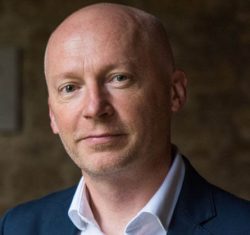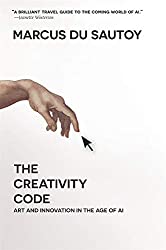A Conversation with Marcus du Sautoy
AI and the Creativity Code
Roundtable discussion: September 24, 2020
Marcus Du Sautoy is a Professor of Mathematics at Oxford University and was appointed to the Simonyi Professorship for the Public Understanding of Science. Having recently released a book called The Creativity Code, Marcus joined us for a roundtable conversation to further discuss the themes of both his book and his PurpleBeach Boxset episode exploring the potential for creativity within AI.
We discussed the implications of code emerging, where computers cannot only produce variations of data they have been provided with, but can also learn and mutate – which enables AI to be creative with things such as art, music, poetry and much more.
One of the first examples of computer creativity in a game happened a few years ago. The computer played a human opponent at a game of GO, surprising everyone by winning 4:1. The most shocking thing was not it winning, but how it came to win. Early in the game, it made an extraordinary move that might traditionally have been seen as weak, which went on to be the move that won the game. If a human had seen the code, it would have been rejected as a bad move, showing how computers can be creative in a way that humans struggle to do as humans are limited by their own assumptions and beliefs based on previous experience.
This raised the question – If a computer can be creative in a limiting game, what else can it do?
What also became clear is that an unhelpful narrative has started to surround computers and AI, the narrative that portrays AI as a competitor to humans that could put humans out of work or even become superior to humans. A more helpful perspective to embrace would be one which views AI as a tool to aid our own creativity, with the “A” in AI standing for “Augmented” or “Additional” Intelligence, rather than “Artificial”
Marcus explained how he views the evolution of AI more positively, as more of a collaboration between joint forces, and how he attempts to lift the bonnet on the things people do not fully understand yet. Humans have created something that has intelligence perpendicular to our own, and the combination of both human and AI is better than each one individually. By combining human and computer creativity, it could open up new opportunities.
As AI has no intentions, it is still the humans giving it the motivation to perform creative activities. We can use AI as a tool, much like a telescope or microscope to be able to discover and explore data we previously didn’t have access to.
Marcus believes that eventually, AI will gain consciousness and have its own intentions, and this will be a new phase in the development of AI, but until then it remains a tool for humans to partner with.
Some struggle to enjoy art created by AI, as humans want to have an emotional connection to the creator. However, Marcus expressed that the artwork is still a reflection of us, as it is created based on data we have given AI from our emotional world. In the same way that you can connect to a novel without knowing the author, we should be able to connect to artwork produced by AI. It is often up to the person consuming the art to bring their own creativity and fill in the gaps.
Interestingly enough, although AI does not have emotions, it is often better at understanding and interpreting our emotional world than humans are. When given data to know the difference between real and false smiles, AI can tell genuine emotions from images of faces. This has proved a useful tool and can be used to help autistic children understand other’s emotions when they aren’t clear.
All in all, a very fascinating discussion, for now AI remains an evolution of us and our own world, AI is on our side, it understands us and our stories and we need to continue to embrace and evolve its creative potential. – thank you again Marcus for your great insights!
Share on facebook
Share on twitter
Share on linkedin
I’d like access to the boxset:
We have a strict door policy at our boxset premier. To gain access to this limited edition boxset, simply fill in the form below.
I’d like more information on the Boxset
The Creativity Code: Art and Innovation in the Age of AI
Marcus du Sautoy
Marcus du Sautoy is Professor of Mathematics at the University of Oxford where he holds the prestigious Simonyi Chair for the Public Understanding of Science and is a Fellow of New College.
Marcus has received a number of awards for his work including the London Mathematical Society’s Berwick Prize for outstanding mathematical research and the Royal Society of London’s Michael Faraday Prize for ‘excellence in communicating science’. He has been awarded an OBE for his services to science and was recently elected a Fellow of the Royal Society.
His mathematical research has covered a great many areas including group theory, number theory and model theory, but he has been equally successful in his promotion of mathematics to the general public. He has published a number of best-selling, non-academic books including his latest book The Creativity Code (4th Estate, 2019) and appears regularly on television and radio.
He talks a language we understand about a language many of us don’t, but then discover we do – what a gift!


